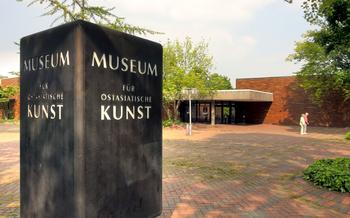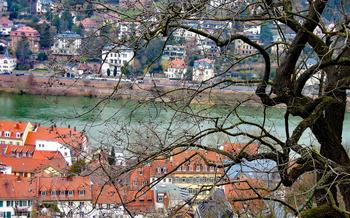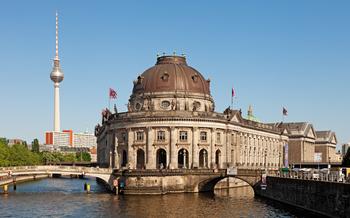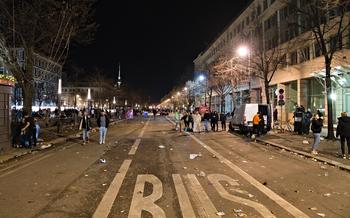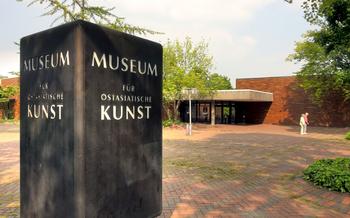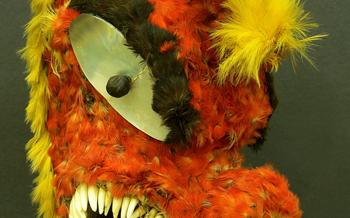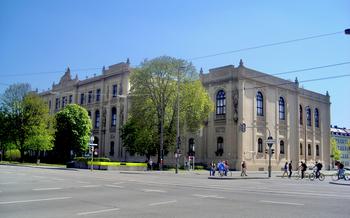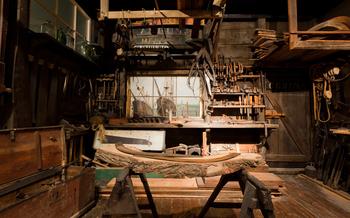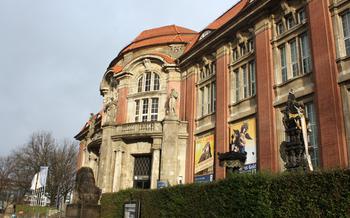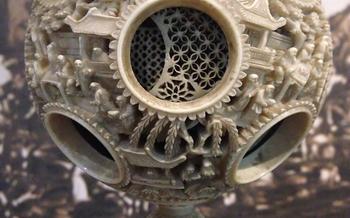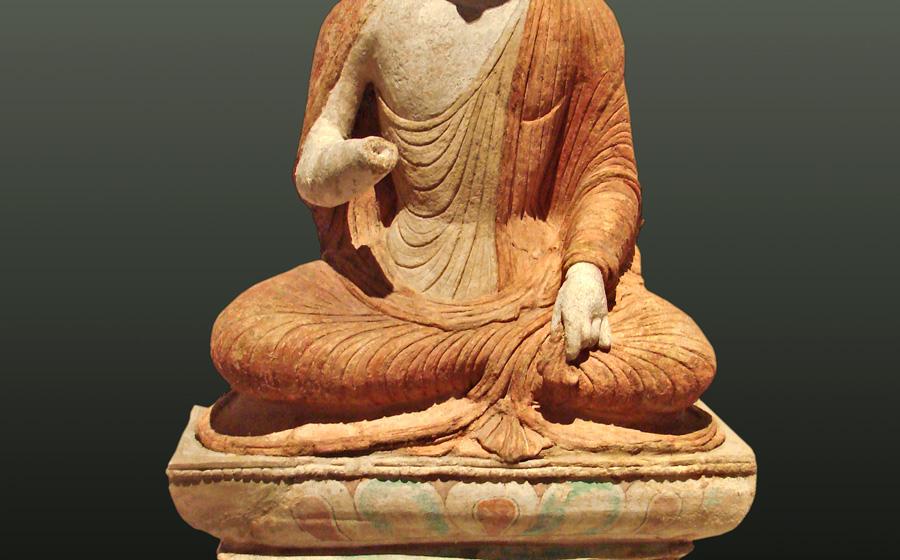
The Museum of Asian Art
- Historical Background
- Collection Overview:
- Chinese Art
- Japanese Art
- Korean Art
- Indian Art
- Southeast Asian Art
- Special Exhibitions
- Educational Programs
- Museum Shop
- Café and Restaurant
- Accessibility
- Nearby Attractions:
- Insider Tip:
Historical Background
The Museum of Asian Art in Berlin, Germany, stands as a testament to the city's rich cultural heritage and its profound connection to the diverse artistic traditions of Asia. Founded in 1906 under the patronage of the Prussian Royal Family, the museum has played a pivotal role in shaping Berlin's cultural landscape.
The museum's origins can be traced to the passion and dedication of a group of collectors and enthusiasts who recognized the significance of Asian art and its unique contribution to global cultural expression. Their unwavering commitment and tireless efforts laid the foundation for the museum's remarkable collection, which now encompasses over 20,000 artifacts spanning a vast geographical area from China and Japan to India and Southeast Asia.
The museum's architectural design, a striking blend of classical and modern elements, reflects the eclectic nature of its collection. The imposing facade, adorned with intricate carvings and sculptures, hints at the treasures that lie within. Inside, visitors are greeted by a series of spacious galleries, each dedicated to a specific region or culture. The harmonious interplay of light and shadow, combined with the thoughtful arrangement of the exhibits, creates an immersive and awe-inspiring experience for visitors.
Collection Overview:
The Museum of Asian Art in Berlin houses a vast and diverse collection of Asian art that spans centuries and cultures. The collection is particularly strong in Chinese, Japanese, Korean, Indian, and Southeast Asian art, with a wide range of mediums represented, including ceramics, bronzes, paintings, sculptures, textiles, and more.
Among the highlights of the Chinese collection are the impressive Tang dynasty horse sculptures, renowned for their realism and intricate detailing. The museum also boasts a significant collection of exquisite jade carvings, showcasing the skill and artistry of Chinese craftsmen.
The Japanese collection is equally impressive, featuring a superb selection of woodblock prints by masters like Hokusai and Hiroshige. These prints depict a variety of subjects, from landscapes and everyday life to historical events and mythical tales. The collection also includes beautiful lacquerware and samurai armor, providing a glimpse into Japanese history and culture.
The Korean collection showcases the unique artistic traditions of Korea, with a focus on celadon ceramics, Buddhist sculptures, and folk paintings. The celadon ceramics, renowned for their delicate green glaze, are particularly noteworthy. The Buddhist sculptures, often depicting serene and compassionate figures, reflect the deep spiritual traditions of Korea.
The Indian collection encompasses a diverse range of artworks, from intricately carved sculptures to vibrant paintings, textiles, and jewelry. The sculptures, often depicting Hindu deities or mythological figures, showcase the skill and artistry of Indian craftsmen. The paintings, ranging from traditional miniatures to modern masterpieces, provide a glimpse into the rich visual storytelling traditions of India.
The Southeast Asian collection offers a glimpse into the diverse artistic expressions of this region, with a focus on Khmer sculptures, Javanese shadow puppets, and Burmese lacquerware. The Khmer sculptures, often depicting scenes from Hindu mythology, are known for their expressive style and intricate details. The Javanese shadow puppets, made from intricately carved leather, represent a unique form of storytelling that is still popular in Southeast Asia today. The Burmese lacquerware, with its vibrant colors and intricate designs, is a testament to the skill and artistry of Burmese craftsmen.
Chinese Art
The Museum of Asian Art in Berlin houses an impressive collection of Chinese art that spans various dynasties and artistic styles. Among the highlights of the collection are the Tang dynasty horse sculptures, renowned for their dynamic poses and intricate details. These majestic steeds, crafted from terracotta, capture the essence of the Tang dynasty's vibrant and cosmopolitan culture. Another notable highlight is the exquisite collection of jade carvings, showcasing the exceptional craftsmanship of Chinese artisans. These intricate carvings, often depicting mythical creatures or auspicious symbols, demonstrate the enduring fascination with jade as a precious material in Chinese culture. The museum's Chinese art collection also includes a diverse range of ceramics, bronzes, paintings, and textiles, offering a comprehensive overview of the rich artistic traditions of China.
Japanese Art
The Museum of Asian Art in Berlin houses an extensive collection of Japanese art that spans various periods and genres. Among the highlights are the exquisite woodblock prints, which showcase the mastery of renowned artists like Hokusai and Hiroshige. These prints depict scenes from everyday life, landscapes, and historical events, offering a glimpse into the rich cultural heritage of Japan.
The museum also boasts a collection of delicate paintings on silk and paper, which showcase the intricate brushwork and vibrant colors characteristic of Japanese art. Visitors can admire the serene landscapes, beautiful portraits, and mythological scenes depicted in these paintings.
Lacquerware, a traditional Japanese art form, is also well-represented in the museum's collection. Visitors can marvel at the intricate designs and superb craftsmanship of these lacquered objects, which range from small boxes and bowls to elaborate furniture pieces.
Another highlight of the Japanese collection is the samurai armor, which provides a glimpse into the history and culture of the samurai warrior class. The museum displays a variety of armor sets, helmets, and weapons, offering insights into the samurai's protective gear and combat techniques.
The influence of Japanese aesthetics on Western art and culture cannot be overstated. The museum's collection of Japanese art serves as a testament to this influence, showcasing how Japanese artistic traditions have inspired and captivated artists and audiences worldwide.
Korean Art
The Museum of Asian Art in Berlin houses a significant collection of Korean art that offers a glimpse into the rich cultural heritage of the Korean peninsula. The collection encompasses a diverse range of artifacts, including celadon ceramics, Buddhist sculptures, and folk paintings, each representing a unique aspect of Korean artistic traditions.
Among the highlights of the Korean collection are the exquisite celadon ceramics, renowned for their delicate green glaze and intricate designs. Visitors can admire the elegant lines and refined craftsmanship of these ceramic pieces, which showcase the mastery of Korean artisans. The Buddhist sculptures, often depicting serene and compassionate deities, reflect the deep religious beliefs and iconography of Korean Buddhism.
Folk paintings, with their vibrant colors and lively depictions of everyday life, provide a fascinating glimpse into the customs and traditions of the Korean people. These paintings often showcase scenes from festivals, celebrations, and rural life, offering a glimpse into the vibrant culture of Korea.
Indian Art
The Museum of Asian Art in Berlin houses a significant collection of Indian art that offers a glimpse into the rich cultural heritage and artistic traditions of the Indian subcontinent. Spanning various periods and regions, the collection encompasses exquisite sculptures, intricate paintings, vibrant textiles, and opulent jewelry.
One of the highlights of the Indian art collection is a magnificent sandstone sculpture of the Hindu deity Shiva, dating back to the 10th century. The sculpture depicts Shiva in his dancing form, Nataraja, with multiple arms and legs, symbolizing his cosmic power and energy. The intricate details and graceful movements of the sculpture capture the essence of Indian religious art and mythology.
Another notable piece is a miniature painting from the Mughal period, depicting a scene from the epic love story of Laila and Majnun. The painting showcases the exquisite craftsmanship and vibrant colors characteristic of Mughal miniature paintings, which often illustrated tales from Persian and Indian literature.
Visitors can also admire a collection of intricately woven textiles, including saris and shawls, which showcase the diverse textile traditions of India. The vibrant colors, intricate patterns, and luxurious fabrics reflect the country's rich cultural heritage and craftsmanship.
The Museum of Asian Art's collection of Indian art offers a comprehensive overview of the subcontinent's artistic achievements, providing visitors with a deeper understanding of India's diverse cultural and religious traditions.
Southeast Asian Art
The Museum of Asian Art in Berlin boasts an impressive collection of Southeast Asian art that reflects the region's rich cultural heritage and diverse artistic traditions. Among the highlights of this collection are the exquisite Khmer sculptures, which showcase the grandeur and sophistication of the ancient Khmer Empire. These sculptures, often depicting deities or mythical creatures, are renowned for their intricate details, serene expressions, and graceful postures.
Another highlight of the Southeast Asian collection is the Javanese shadow puppets, which offer a glimpse into the region's vibrant performing arts traditions. These intricately crafted puppets, made from leather or parchment, are used in shadow plays that tell stories from mythology, history, and daily life. The puppets' delicate silhouettes and expressive gestures captivate audiences, showcasing the artistry and storytelling prowess of Javanese craftsmen.
The museum's collection also includes a range of Burmese lacquerware, which demonstrates the country's unique artistic techniques and craftsmanship. Lacquer, a natural resin derived from trees, is applied in multiple layers onto various objects, such as bowls, plates, and furniture, creating a durable and lustrous surface. Burmese lacquerware is often decorated with intricate designs and patterns, often inspired by nature or religious motifs, showcasing the skill and patience of Burmese artisans.
Exploring the Southeast Asian art collection at the Museum of Asian Art offers visitors a profound appreciation for the region's diverse cultural expressions and artistic achievements. Whether it's the grandeur of Khmer sculptures, the intricate beauty of Javanese shadow puppets, or the vibrant colors of Burmese lacquerware, the museum provides a captivating journey through the artistic heritage of Southeast Asia.
Special Exhibitions
The Museum of Asian Art in Berlin not only houses a permanent collection of Asian masterpieces but also organizes a variety of special exhibitions throughout the year. These exhibitions delve into specific themes, showcase the works of renowned artists, or explore the artistic traditions of particular regions. Past exhibitions have covered topics such as the history of Chinese calligraphy, the vibrant world of Japanese ukiyo-e prints, and the exquisite craftsmanship of Korean celadon ceramics.
Special exhibitions at the Museum of Asian Art offer visitors a unique opportunity to gain deeper insights into the diverse cultures and artistic expressions of Asia. They provide a platform for showcasing hidden treasures from the museum's vast collection, as well as presenting works on loan from other institutions and private collections. The exhibitions are often accompanied by educational programs, lectures, and workshops, allowing visitors to engage with the art and learn from experts in the field.
These special exhibitions not only enhance the museum's offerings but also attract new audiences, including art enthusiasts, scholars, and tourists with a specific interest in Asian art. They contribute to the museum's mission of promoting cultural understanding and appreciation, while also generating revenue to support its ongoing operations.
Educational Programs
The Museum of Asian Art in Berlin is dedicated to promoting cultural understanding and appreciation through its extensive educational programs. These programs cater to diverse audiences, from students and researchers to the general public, providing opportunities for learning, engagement, and exploration of Asian art and culture.
Guided tours led by knowledgeable docents offer visitors an in-depth look at the museum's collection, highlighting the historical, cultural, and artistic significance of the exhibits. The tours are tailored to different interests and levels of expertise, ensuring that everyone can gain valuable insights into Asian art.
Workshops and lectures are regularly organized to delve deeper into specific themes, techniques, and artists. These programs provide a platform for experts and enthusiasts to share their knowledge and perspectives on Asian art, fostering a vibrant community of learning and exchange.
The museum also offers educational resources such as online courses, interactive exhibitions, and multimedia guides. These resources allow visitors to explore the collection at their own pace, access additional information, and engage with the artworks in new and innovative ways.
By providing a diverse range of educational programs, the Museum of Asian Art in Berlin plays a crucial role in promoting cultural understanding, fostering appreciation for Asian art, and inspiring future generations of art enthusiasts and scholars.
Museum Shop
The Museum of Asian Art in Berlin houses a well-stocked shop that caters to the needs of visitors looking for unique souvenirs, books, and art-related gifts. The shop offers a wide range of items, from traditional handicrafts to contemporary creations inspired by Asian art. Visitors can find exquisite jewelry, delicate ceramics, intricately carved wooden figurines, and colorful textiles that reflect the diverse cultures represented in the museum's collection.
For those seeking a deeper understanding of Asian art and culture, the shop offers a selection of books, catalogs, and guides that explore various artistic traditions, historical periods, and thematic exhibitions. These publications provide valuable insights into the masterpieces showcased in the museum and serve as a lasting reminder of the visit.
The museum shop also supports local artisans and emerging artists by featuring their unique creations. Visitors can discover one-of-a-kind pieces that showcase contemporary interpretations of traditional techniques and styles. Whether it's a hand-painted scroll, a ceramic tea set, or a piece of modern jewelry, these items offer a unique way to bring a touch of Asian art into one's home.
By supporting the museum shop, visitors contribute to the museum's mission of promoting cultural understanding and preserving artistic heritage. The revenue generated from sales helps fund educational programs, conservation efforts, and new acquisitions, ensuring that the museum continues to offer exceptional experiences to visitors from around the world.
Café and Restaurant
The Museum of Asian Art offers a delightful culinary experience for visitors, with its charming café and elegant restaurant. Located within the museum's premises, these dining establishments provide a welcome respite from the exploration of the vast collection.
The café offers a relaxed ambiance, perfect for a quick bite or a refreshing drink. Visitors can savor a variety of light meals, sandwiches, salads, and pastries, all prepared with fresh, high-quality ingredients. The café's menu also features a selection of specialty teas and coffees, providing a perfect accompaniment to the museum's artistic treasures.
For a more formal dining experience, the museum's restaurant is an excellent choice. The elegant setting and attentive service create a sophisticated atmosphere, making it an ideal spot for a special occasion or a leisurely lunch. The restaurant's menu showcases a range of culinary delights, including traditional German dishes with a modern twist and international cuisine inspired by the museum's Asian collection.
Whether you're looking for a quick snack or a leisurely meal, the Museum of Asian Art's café and restaurant offer a memorable dining experience that complements the museum's artistic offerings.
Accessibility
The Museum of Asian Art is committed to ensuring that everyone can enjoy its offerings, regardless of their abilities. Accessibility features include wheelchair ramps, elevators, and audio guides for the visually impaired.
-
Wheelchair accessibility: The museum is fully accessible for wheelchair users, with ramps and elevators providing access to all floors.
-
Visual impairment accessibility: The museum offers audio guides for visitors with visual impairments, allowing them to experience the collection in a meaningful way.
-
Hearing impairment accessibility: The museum provides sign language interpreters for guided tours upon request, ensuring that visitors with hearing impairments can fully participate in the museum's educational programs.
The museum's commitment to accessibility is evident in its design and services, making it a welcoming and inclusive space for all visitors.
Nearby Attractions:
The Museum of Asian Art is conveniently located in the heart of Berlin's cultural district, surrounded by other world-renowned museums and attractions. Just a short walk away, visitors can explore the Pergamon Museum, home to the awe-inspiring Ishtar Gate of Babylon and the Market Gate of Miletus. The Brandenburg Gate, one of Berlin's most iconic landmarks, is also within easy reach, as is the Reichstag Building, the seat of the German parliament.
The Pergamon Museum houses an impressive collection of ancient artifacts from the Middle East, including the monumental Pergamon Altar, a masterpiece of Hellenistic sculpture. The Brandenburg Gate, built in the 18th century, is a symbol of German unity and a popular tourist destination. The Reichstag Building, designed by Norman Foster in the late 1990s, is a striking example of modern architecture and offers breathtaking views of the city from its rooftop terrace.
Visiting these nearby attractions along with the Museum of Asian Art allows for a comprehensive exploration of Berlin's rich cultural heritage and diverse architectural styles. Whether you're interested in ancient history, modern politics, or simply taking in the city's iconic sights, there's something for everyone within walking distance of the museum.
Insider Tip:
For an extraordinary experience, visit the museum during one of its special evening events, such as the "Lange Nacht der Museen" (Long Night of Museums). During this annual event, the museum stays open until late, offering visitors a unique opportunity to explore the galleries in a relaxed atmosphere, accompanied by live music and special performances. It's a great way to see the museum from a different perspective and enjoy a memorable night of art and culture.
